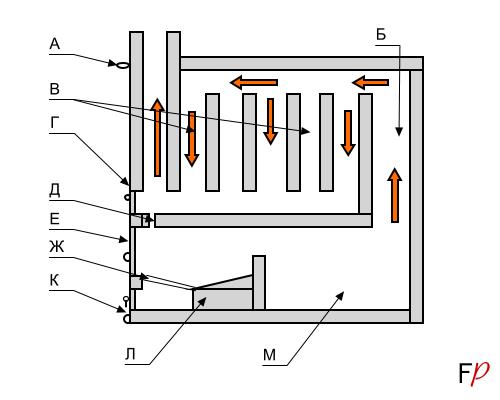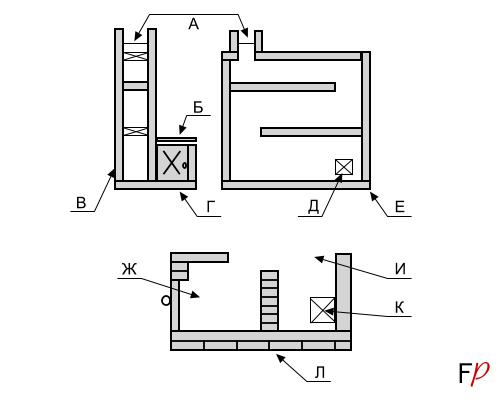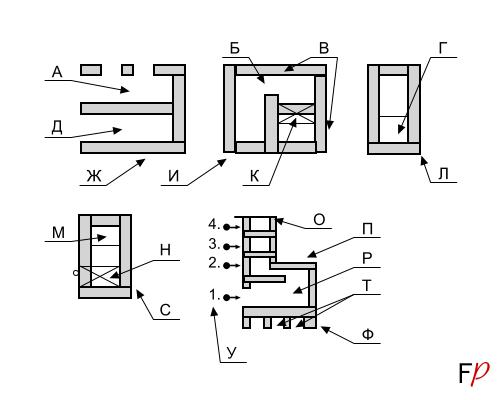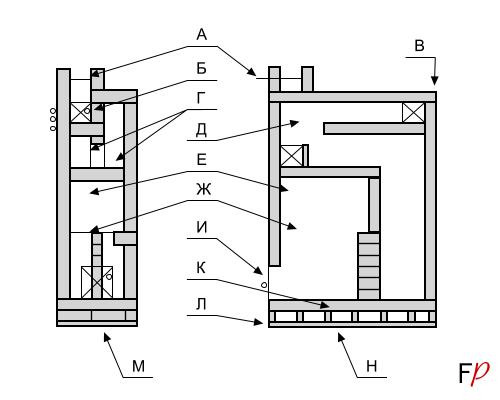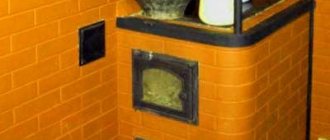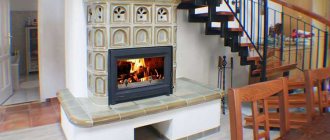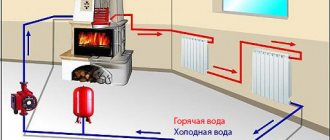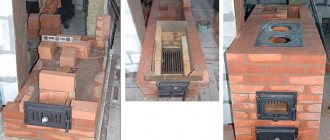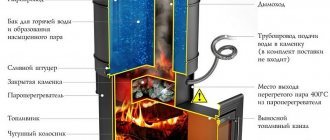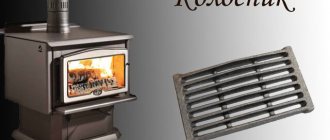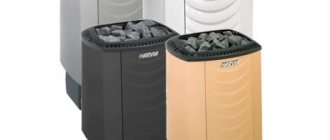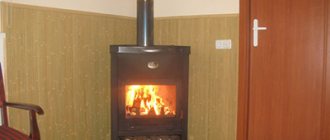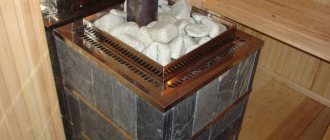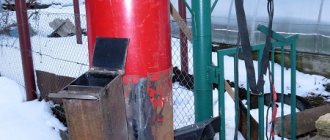Thoughtful 19th century furnace
Heating stove, the diagram of which is shown in the figure
| Fig. 17. Diagram of one of the most technically thought-out furnaces of the 19th century | |
| A. Common draft gate B. First lift well C. Parallel wells D. Clean-out door E. Direct draft suction E. Furnace door G. Grizzly plates K. Blowing door L. Under the furnace M. Afterburner chamber |
> This stove can be easily converted into a cooking-heating stove if the firebox is taken out to the side of the stove, correspondingly equipped with a stove, and the bottom of the flue ducts is lowered to the floor level.
A feature of this furnace, which was obviously developed by V.A.Stroganov, is the presence of: a) afterburner chamber; b) technically competent distribution of the direction and location of the channels, allowing to achieve uniform heating of the entire area of the smoke wells of the furnace; c) a calibrated direct draft suction hole; d) just one cleaning door, which makes it easy and simple to clean all the wells; if necessary, through it, you can get rid of the overturning of the draft in the furnace; e) grate and hearth of the furnace, which are arranged under well thought-out slopes, contributing to more efficient combustion of fuel residues than in furnaces with a strictly horizontal arrangement of the grate and hearth of the furnace. The stove with this arrangement of chimneys will evenly warm up over its entire heat-transfer area. The draft in such ovens is always good.
4. A heating stove with horizontal smoke wells (Fig. 18) is good in that it does not require strict and precise fixed markings at the chimney outlet. In pre-revolutionary times, such markings could only be done by a senior kiln master. The marking of the foundation and the laying of the first row has never been entrusted to apprentices. And not at all because it was a "matter of honor." The reason for this strictest subordination was by no means a formality, but the possibility of committing a fatal mistake.
Hearth ovens: purpose and features
Hearth ovens rightfully occupy a special place in the range of equipment for the production of bakery and confectionery products. This type of stove can rightfully be attributed to the oldest type. The hearth furnaces are based on the principle of heating the hearth, which then evenly transfers heat to the working chamber. Thanks to this, the products in the oven are evenly heated and do not burn.
The traditional hearth is made of refractory materials. It can be natural stone, ceramics, fireclay clay.
No matter how difficult it is to guess, the traditional ovens for baking bakery products in many nations of the world are hearth - this is a Russian oven for pies and loaves, and an Italian wood-burning pizza oven.
At present, in addition to stone, ceramics and refractory chamotte clay, metal hearths are also used as a hearth material. However, stone hearths are most preferred. Therefore, before buying a hearth oven, first of all, you should pay attention to the quality of the hearth. You should be aware that any pod has a limited service life and is designed for a certain number of heating and cooling cycles. And the better underneath, the longer it will last. High-quality pod serves for years and even decades. Nevertheless, when buying ovens, you should pay attention to the possibility of completing with spare hearths in order to be able to replace the one that is out of order.
Hearth ovens:
The main purpose of the hearth ovens is to bake bread, bakery products, pizzas and pies. In serial production, multi-deck hearth furnaces are used. That is why another name for this type of oven is deck ovens.
Hearth ovens differ among themselves not only in the material of the hearth, but also in the type of heat source. The most popular are gas hearth ovens and electric ones.
Electric hearth ovens are more expedient to use when baking confectionery and bakery products directly at catering establishments, in stores selling fresh baked goods, since they are compact and efficient.
Modern deck ovens have several chambers, for each of which you can set an autonomous baking mode. Therefore, it is advisable to purchase deck ovens equipped with programmable control panels. On such ovens, it will be possible to comfortably bake several types of bakery or confectionery products at the same time.
Deck ovens, in addition to a programmable control panel, are often equipped with other additional devices. One of the most popular options is the steam generator, which is essential when baking yeast dough products. The steam in the working chamber not only creates a special baking mode, but also contributes to the glossiness of the finished product.
It is also recommended to purchase ovens with illumination in the working chambers and windows made of heat-resistant glass, which provides visual control over the baking process.
offers more than two dozen different models of deck ovens that have proven themselves among bakers and confectioners in Russia and the CIS countries. Our experts will help you choose a reliable deck oven model that is optimal in terms of performance and price.
Heating stove made of bricks by Sergei Mikhailov (drawings)
| Fig. 18. Oven by Sergei Mikhailov. The location of all technological units of the furnace is given taking into account the recommendations given in this chapter. | |
| A. Common draft gate valve B. Stove C. Chimney section (front view) D. Furnace door E. Exit from the furnace to the first well (hailo) E. Chimney section (side view) J. Furnace I. Stove K. Haylo L. Section of the furnace furnace (side view) |
The fact is that the senior kiln master had to “keep in mind” the whole kiln as a whole. He "saw" all the higher ceilings, directions, the number of future chimneys, etc. All this is true now, but not in relation to stoves with a horizontal arrangement of smoke channels. Such a stove (Fig. 18) does not require any special design skills, because all the technological difficulties in the chimney "linking" the dimensions of the stove move from the horizontal plane to the vertical one.
Furnaces with horizontal wells were undeservedly forgotten. The cause of forgetting is either ignorance or ignorance of the laws that I described in chapters 28 and 29 of this book. There is an opinion that stoves with horizontal wells are supposedly quickly clogged with ash, it is more difficult to clean them, etc. This is absolutely wrong. You can get rid of these completely unfounded prejudices by reading the above chapters in more detail.
Now I will limit myself to only a brief listing of the main advantages of a furnace with horizontal wells: a) does not require an exact calculation when marking the first row; b) it warms up evenly (the hottest parts of the furnace, which allow intensive heat removal, are at the bottom, and the less hot ones gradually move to the upper zone of the heated room); c) cools down evenly (heat from the lower rows of the furnace is gradually transferred to the upper rows. And since the period of intense heat transfer and cooling of the furnace is the same period, measured in several hours, this is another plus of the furnace with horizontally located smoke channels); d) allows you to completely integrate arched dryers into the oven masonry (Fig. 19).
It is recommended to place the oven on a trench hearth (see fig. 1 and item 11 of chapter 15).
| Fig. 19. Sergei Mikhailov's stove with a built-in niche-dryer, side section (the proportions of the combustion chamber are shown in Fig. 18) | |
| A. Bolt B.Clean-out door B. Dryer D. Clean-out door D. Haylo E. Sectional view of smoke wells, side view | |
| Fig. 20. Scheme of wells: summer and winter options, side section | |
| A. Winter valve B. Summer valve V. Haylo | |
If the customer relied entirely on my choice, I have always preferred the horizontal well stove. "Complaints" about this type of stove were surprisingly monotonous: for every extra log thrown into a burning furnace, one had to pay with the unbearable heat in the house.
5. Smoke wells, the diagram of which is shown in fig. 20, can be useful when laying a heating and cooking stove, taking into account the "summer version".
6. The furnace, the horizontal sections of which are shown in fig. 21, allowed the author of this book to heat it once a day, even with the onset of prolonged 35-degree frosts. At the same time, the air temperature in the room never dropped below + 19 °.
The features of this furnace scheme are as follows: a) eight short horizontal wells; b) the maximum area of heat transfer in the lower part of the furnace (it is recommended to lay the furnace on a trench hearth, see Fig. 11, as well as paragraph 11 of Chapter 15); c) significant heat capacity; d) additional gate valve with "summer option"; e) a horizontal portable "lounger", on which it is convenient to dry wet shoes, clothes, etc.
Author's brick oven by Sergei Mikhailov
| Fig. 21. Author's stove by Sergei Mikhailov. | |
| A. Winter valve B. Summer haylo C. Entrance to the fifth well D. Summer valve D. Section of the second row E. Entrance to the seventh well G. Section of the bottom row of wells I. Fire chamber K. Pipe L. Exit from the eighth well into the sixth M .Section of the third row |
7. The heating stove on the trench (Fig. 22) has one (in my opinion, insignificant) drawback: it does not have grates. Deaf under (no grate) in cooking-heating and heating stoves in Soviet times was even prohibited by a special directive! The reason for the ban was "unsatisfactory combustion of fuel in such a firebox, firewood, and even more so coal, peat and briquettes." The "All-Union Generalissimo for Stove Construction", to put it mildly, has gone too far in this matter. But when using coal, peat and briquettes as fuel, it is really impossible to do without a grate in the furnace.
| Fig. 22. Author's stove-fireplace by Sergei Mikhailov. | |
| A. Empty well B. Entrance to the first well C. Lezhak D. Entrance to the second well D. Fire chamber J. Section of the first row I. Entrance to the third well K. Khailo L. Section of the third row M. Entrance to the third well N. Catch O. Latch P. Lezhak R. Fireplace C. Section of the fourth row T. Shantsy U. Numbering of sections F. Vertical section, side view |
A feature of this type of oven is: a) the presence of a remote (high) "lounger"; b) the absence of a stove door, which tells the stove many of the advantages of a fireplace with its high efficiency; c) very good heating of the lowest layers of air in the living room. But this is very important when there are small children in the house - as you know, they spend most of their time on the floor. Note that in this oven the bread is baked well and evenly. I also had to heat this stove only once a day, even during the most severe and prolonged frosts. Many authors of books on stove that I respect, express serious doubts that a stove with an open fire door will keep the house warm. Indeed, in this case, the inner walls of the smoke wells are cooled with air that does not participate in the chemical processes of complete combustion of the fuel. All of this is fair. But not for the type of oven shown in fig. 22. After all, as mentioned above, she has no stove door at all.
Why is that? I will briefly explain: a) the area of the inlet was, of course, not a fireplace, it had a height of 25 cm and a width of 30 cm. Even the smallest increase in these dimensions would necessarily lead to a weakening of the overall draft of the stove and even to the fact that it would start to smoke; b) there were no grates in the oven; c) a high furnace, obviously, significantly slowed down the speed of movement of air masses, and the air slowly passing through the furnace had time to warm up thoroughly.A characteristic feature of this furnace was that after three years of its intensive operation, I could not scrape together even 500 grams of ash residues at the entrance to the first horizontal rise (where the most ash usually accumulates).
8. In fig. 23 shows a diagram of a Dutch cooking and heating woman on the trenches. Actually, there are no Dutch cooking and heating women. Dutch woman Is a heating stove without a stove, the wells of which are located above the firebox.
Dutch woman made of bricks by Sergei Mikhailov
| Fig. 23. Designer Dutch oven by Sergei Mikhailov. | |
| A. Latch B. Clearing door C. Passage to the fourth well D. Double wells D. Passage to the third horizontal well E. Niche J. Stove I. Furnace door K. Shantsy L. Fireproof masonry M. Section from the front N. Section from the side |
But among the people there is an established opinion that the stove, the wells of which are located above the furnace, is a Dutch woman. And in the outback, any stove, at least slightly different from the classic Russian, is taken for a Dutch woman.
This oven is convenient in rooms with limited space. Its characteristic features are: a) a vertical post at the rear of the furnace, designed to support the kitchen stove; b) trenches, which greatly increases the area of intense heat removal; c) horizontal wells, the merits of which were mentioned in paragraph 4 of this chapter; d) significant (almost maximum) heat capacity, intended for furnaces of medium power, periodic furnace. It is indisputable that stoves designed for a permanent fire can have a high heat capacity. But it should be borne in mind that the combustion processes in continuous furnaces, and even more so in furnaces designed for solid and liquid fuels, as well as the principles of constructing a furnace and furnace wells (continuous operation) will differ significantly from the principles recommended for batch furnaces (1, 5-2 hours of heating in the morning and evening every day).
Briefly about the differences between batch and continuous ovens, the following can be said. With intermittent heating, in 0.5-1 hour the inner surface of the walls can heat up to 800-900 ° C. Hence, the inevitable appearance of cracks and ruptures in the furnace seams already in the first year of operation of batch furnaces. With continuous firing, fuel consumption is sharply reduced (as applied to coal, gas and liquid fuel) and the heating temperature of the walls is reduced to 450-500 C. Therefore, fireboxes of intermittent furnaces are usually lined with refractory bricks (the temperature limit of high-quality red bricks usually reaches only 700-750 C), and fireboxes of continuous stoves do not need this (excluding the use of anthracite).
9. In fig. 24 shows a diagram of a kitchen summer stove.
Design features
In most cases, the portable kiln is the main competitor among existing heat sources and structures for firing and cauldron. It is difficult to compare this functional device with a wood-burning stove or any other solid and liquid fuel.
Simplicity is the main difference of this unit during operation. In warm weather, it will take no more than 2 hours to warm up, and in winter it will take a maximum of 4-5 hours to obtain the desired temperature.
For a gas-fired kitchen hearth oven with oven, certain rules must be observed regarding the installation of the boiler. The approximate service life is not much, not a little - about 25 years, and if preventive and repair work is carried out in a timely manner, then the furnace will last at least twice as long.
If you can visualize the elements that make up the basis of a portable hearth kitchen oven with an oven that runs on wood or any other liquid and solid fuel, then not everyone can understand the design of a gas oven. This requires certain skills and experience. But this is not a problem either - it is necessary to understand the features. Gas portable oven for home heating, kitchen or baking bread, includes the following items:
- A protective case that eliminates disturbances for the internal contents.
- A fuse that ensures the termination of the gas supply in the event of attenuation.It should be noted that the system using firewood does not have such an opportunity.
- Responsible for the thermal properties is the thermostat.
- Sealed hearth furnace chamber, on the integrity of which your own safety depends. In the process of selection and acquisition, you need to clearly follow this.
- The chimney is a part of the structure that provides the removal of combustion products. In addition, it is also a source of heat.
Despite the rather harsh conditions related to the use of gas in everyday life, ceramic kilns that run on this fuel are widespread and safe. The main feature is functionality and low cost in the process of use. In addition, such devices are more environmentally friendly than wood-burning counterparts.
Thanks to this equipment, the room heats up as quickly as possible, and the degree of heat retention depends on the season and the temperature “overboard”. Thanks to high-quality and uniform heating, comfortable conditions are achieved in any room.
A portable gas stove for a bath practically does not differ in design from similar devices, but it still has a number of features. This primarily concerns the type of fuel used. In such devices, in addition to the thermostat, a fuse is needed, which is triggered at the moment the burner goes out - the gas supply stops. The combustion chamber is located directly under the stove, which allows the stones to warm up quickly.
For gas firing devices, as well as for wood-burning devices, a chimney is required to remove combustion products. Such stoves provide the best steam in the bath, quick heating of the heater and the steam room itself. The uniform heat distribution ensures a stable temperature.
The simplest brick kitchen stove
| Fig. 24. The simplest kitchen oven. | |
| A. Latch B. Spark-extinguishing tooth C. Slab D. Fire chamber D. Slab E. Side cut G. Front cut | |
Characteristics:
a) very low height of the firebox - only 21 cm (if someone does not like this size, the height of the firebox can be raised, but in this case, two to three times more firewood will be needed for cooking). It is best to use an old picket fence and unnecessary remnants of lumber as firewood in a stove with a similar furnace height. Two or three old pickets will be enough to prepare a full meal in the summer for a family of six. However, in our time, when the majority of rural residents use gas or electricity for cooking, an oven of this height is unlikely to find its mass user;
b) the presence of a spark extinguishing tooth and the absence of everything superfluous.
OP 3
Heating stove with a stove bench


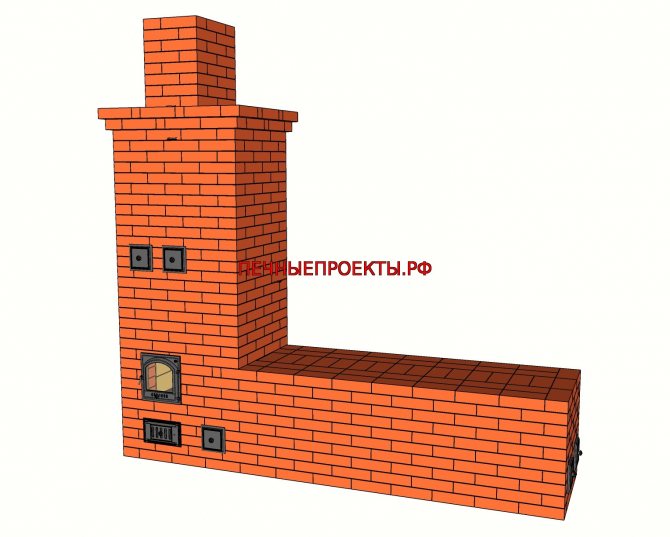

- Dimensions: 2930mm * 770mm
- Heated room: up to 40 sq.m.
- Number of bricks: 1020pcs
- Gas flow diagram: channel
